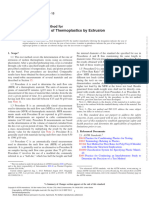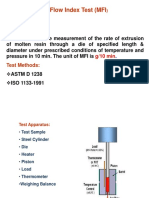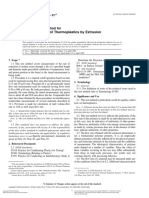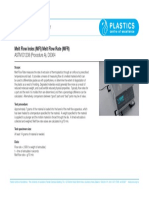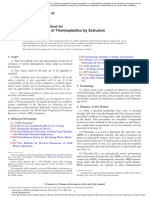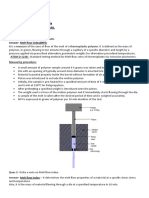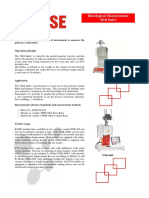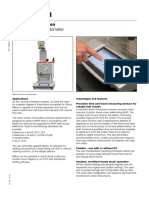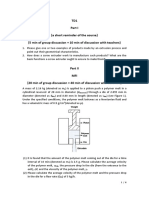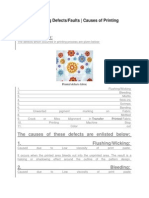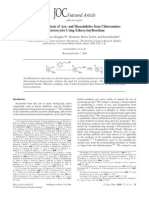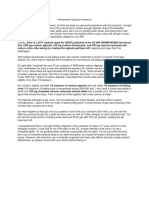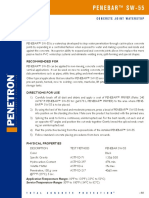Lab 2
Determination of Melt Flow Rate by Extrusion Plastomer
Introduction
• Melt flow rate is the rate of extrusion of a thermoplastic
material through an orifice of designated dimensions
under prescribed temperature and pressure. (g/10 min)
• Other terms for melt flow rate (MFR) include Flow rate,
Melt Flow Index (MFI), Melt Index (PE’s FR 190/2.16),
Melt volume rate (MVR) in cm3/10 min
• Significance
o Characterize the behavior of molten plastics (not
processability)
o Measuring the uniformity of the flow
o Quality control
o Differentiate the grade of polymer
o Determine the extent of degradation
o Comparison of raw material with the regrind from the
finished parts
o Prediction of molecular weight (with caution!)
1
∝ M3.4
w
to 3.7
MFR
This equation is only valid when the molecular weight
distribution shape is invariant.
� o Prediction of the molecular weight distribution
Low MFR: Narrow MWD
High MFR: Broad MWD
• Correlation of MFR and processability does not exist
o The shear rate in melt index test is very different from
the shear rate in extrusion or molding processes
o The effect of additives cannot be observed via the
melt flow rate test
Equipment
Ray-Ran Melt Flow Indexer MK II Digital Model 2 “A”
The equipment consists of
1. Cylinder
2. Die
3. Piston
4. Heater
Test Sample
Powder, granule, film, or palletized powder
Procedure
• Procedure A: Manual operation
• Procedure B: Automatically timed flow rate
measurement
�Procedure A: Manual Procedure B: Auto
Check the equipment Check the equipment
Select test condition Select test condition
(190/2.16) (190/2.16)
Insert the die and the Insert the die and the
piston in the cylinder piston in the cylinder
Wait 15 min Wait 15 min
Remove the piston Remove the piston
Add samples Add samples
Allow sometime to melt Allow sometime to melt
Purge samples out Purge samples out
until the line on the plunger lie until the line on the plunger lie
up with the top of cylinder up with the top of cylinder
Select distance (L)
Start timer and make 6.35 mm for MFR ≤ 10
the initial cut-off 25.4 mm for MFR > 10
Make initial cut-off
Stop timer when time when the auto timer starts
interval is reached and
make the final cut-off Make the final cut-off
when the auto timer stops
Weigh the extrudate
Weigh the extrudate
MFR =
427 × L (cm) × d ( ).
g
cm3
t (sec.)
600
MFR = × wt.( g) “d” from Meth. II
t (sec.) “d” from Meth. I
�Calculation of “d”
• Method I: Based on the article by Paul Zoller
1 1
d = =
V Vo exp(α 0 T )
where d = density (g/cm3)
V = specific volume
V0 = 1.1511 cm3/g
α0 = 6.78 x 10-4 °C-1
T = test temperature, °C
Assumption:
190°C, the difference in density of HDPE, LDPE, and
LLDPE are not significant.
• Method II:
D
W
d =
Vol
where d = density, g/cm3 L
W = weight of extrudate, g
Vol = volume of extrudate = A x L, cm3
A = π(d/2)2, cm2
D = avg. diameter of cylinder and piston
�Report must includes
1. Information required by ASTM
a. Nature and physical form of the test specimen
b. Test condition (in standard form)
c. Melt flow rate or melt index of sample
d. Procedure used
e. Any unusual behavior of the test
2. Analysis and discussion
a. Statistical comparison between 3 calculated melt
index
b. Discussion of the accuracy of each procedure
(manual, auto (Method I), and auto (Method II))
c. Discussion on molecular weight and molecular
weight distribution of samples.
